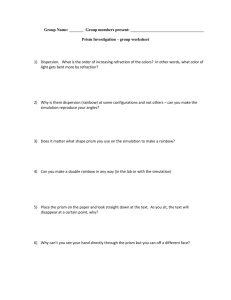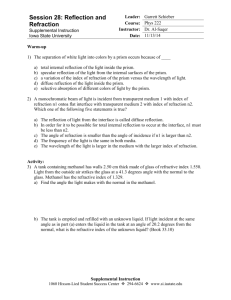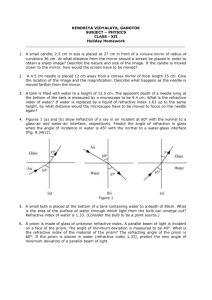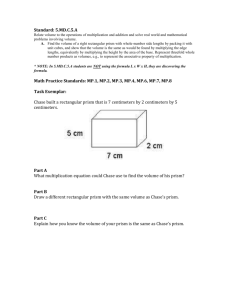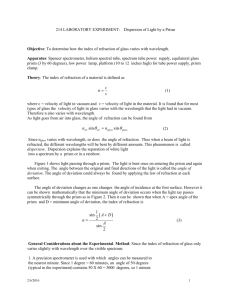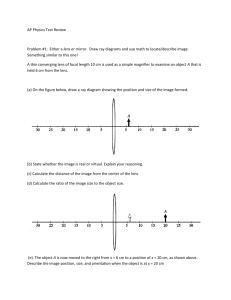The Spectrometer
advertisement
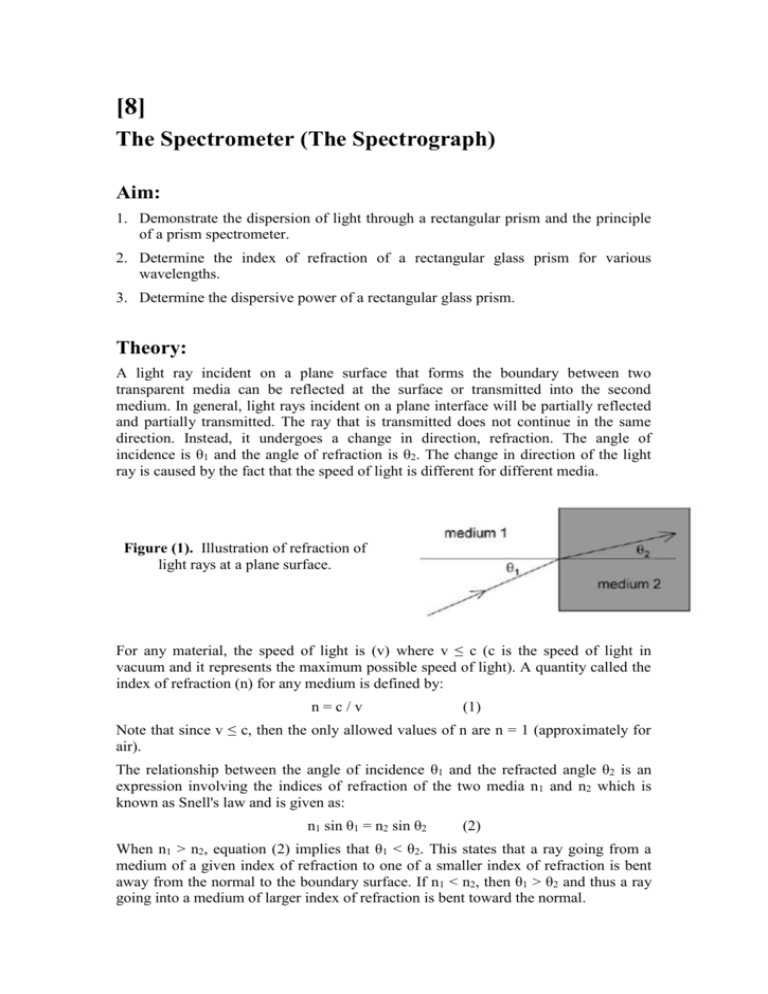
[8] The Spectrometer (The Spectrograph) Aim: 1. Demonstrate the dispersion of light through a rectangular prism and the principle of a prism spectrometer. 2. Determine the index of refraction of a rectangular glass prism for various wavelengths. 3. Determine the dispersive power of a rectangular glass prism. Theory: A light ray incident on a plane surface that forms the boundary between two transparent media can be reflected at the surface or transmitted into the second medium. In general, light rays incident on a plane interface will be partially reflected and partially transmitted. The ray that is transmitted does not continue in the same direction. Instead, it undergoes a change in direction, refraction. The angle of incidence is θ1 and the angle of refraction is θ2. The change in direction of the light ray is caused by the fact that the speed of light is different for different media. Figure (1). Illustration of refraction of light rays at a plane surface. For any material, the speed of light is (v) where v ≤ c (c is the speed of light in vacuum and it represents the maximum possible speed of light). A quantity called the index of refraction (n) for any medium is defined by: n=c/v (1) Note that since v ≤ c, then the only allowed values of n are n = 1 (approximately for air). The relationship between the angle of incidence θ1 and the refracted angle θ2 is an expression involving the indices of refraction of the two media n1 and n2 which is known as Snell's law and is given as: n1 sin θ1 = n2 sin θ2 (2) When n1 > n2, equation (2) implies that θ1 < θ2. This states that a ray going from a medium of a given index of refraction to one of a smaller index of refraction is bent away from the normal to the boundary surface. If n1 < n2, then θ1 > θ2 and thus a ray going into a medium of larger index of refraction is bent toward the normal. In general, the index of refraction is not the same for all light wavelengths (colors). This implies that, for a given incident light, the refraction angle will depend on the wavelength of the incident light. The phenomenon whereby the index of refraction of a material measurably depends on the wavelength of the incident light is called dispersion. Empirically, the relationship between the index of refraction and the wavelength of light is known as Cauchy's formula: n=A+ B λ2 (3) Where, A and B are called Cauchy's constants. An optical glass triangular prism is a transparent medium. Consider a light ray obliquely (not perpendicular) incident on the left hand side of the prism, Figure (2) illustrates a typical path for the light ray transiting. The angles θ1, θ2, θ'1 and θ'2 are the incident angle from medium 1 to medium 2, the refraction angle within medium 2, the incident angle from medium 2 to medium 1, and the refraction angle out into medium 1, respectively. They are related according to Snell's law as follows: and n1 sin θ1 = n2 sin θ2 (4) n1 sin θ'1 = n2 sin θ'2 (5) The light exits the prism through right hand side at an angle θ'2 with respect to the normal to side B. If we draw a line along the direction of the incident ray through the prism, it will intersect side B at an angle of ω with respect to the normal to that surface (Figure 2). Figure (2). Geometric relations for refracted rays within a prism. Figure (3). Geometric relations when light passes through a prism symmetrically. The deviation angle (δ) is defined as the angle between the initial direction of the light ray and its final direction. Inspection on Figure (3) shows that the deviation angle is given by: δ = θ'2 + ω It can be further shown that: (6) δ = θ1 + θ'2 – A (7) Where, A is the angle formed by the leading edge of the prism. If the angle of incidence θ1 is varied from some arbitrary starting value, either by moving the light source or rotating the prism, the deviation angle (δ) will become smaller until it reaches a minimum value, after which continued adjustment of θ1 will cause the deviation angle to increase again. This special, smallest, value of δ is called the angle of minimum deviation (δm). The conditions for δ to be minimum deviation are: θ1 = θ'2 and θ2 = θ'1 A light ray incident on the prism at an angle θ1 such that the above condition is satisfied will pass through the prism symmetrically as in Figure (3). Further geometric manipulations reveal that when the minimum deviation conditions are satisfied, θ1 and θ2 obey rather simple conditions: θ2 = θ1 = θ2 + A 2 δ m A δm + 2 2 Taking the index of refraction of air to be n1 = 1 and inserting the above relations for θ1 and θ2 into Snell's law gives a simple equation for the index of refraction of the prism, n2 = n, in terms of the angle of minimum deviation (δm): n= sin θ1 = sin θ 2 A δm ) 2 A sin ( ) 2 sin ( (8) In a dispersive material, the index of refraction depends on the wavelength of the incident light (λ). By measuring the angle of minimum deviation for different light wavelengths, we can determine the wavelength dependence of the index of refraction by using the equation: sin θ1 n(λ) = = sin θ 2 A δ m ( ) ) 2 A sin ( ) 2 sin ( (9) The Spectrometer (The Spectrograph): The spectrometer (the spectrograph) is an instrument for the production of spectra and is provided with the necessary arrangements for the measurements of deviation. It consists of mainly three main parts: a collimator, a telescope, a prism and a circular spectrometer table (Figure 4). - The collimator: The collimator serves to provide a parallel beam of light from the source. It comprises a tube with an achromatic lens at one end and an adjustable slit at the other. - The prism: A suitable prism is required to disperse the light and is mounted on a revolving table above the main table of the spectrometer. - The telescope: The function of the telescope is to receive the dispersed rays and is provided with cross wires for measurements of the deviation. Figure (4). Schematic diagram of the prism spectrometer. Adjustment of the Spectrometer: The optics axes of collimator and telescope intersect on the common axis of rotation of the prism and telescope, but before use, certain adjustments have to be made as follows: - Cross wires: The eyepiece of the telescope is adjusted until the cross wires are seen distinctly. - Telescope: The telescope is directed towards a distant object and is adjusted by means of the focusing screw until there is no parallax between the image of the distant object and the cross wires. - Collimator: Having set the telescope to receive parallel light, it is now turned to receive light from the collimator illuminated by a sodium lamp. The position of the slit is adjustment until its image is clearly seen in the telescope. The collimator now gives parallel light. - Prism: The prism is placed with its refracting edge towards the collimator and the telescope moved round to receive an image of the slit reflected from one face. The telescope is now fixed and the leveling screws are adjusted on the prism table so that the image is in the center of the telescope's field. The prism table is rotating until the image from the second face (meeting at the refracting edge) is received by the telescope. The necessary adjustments are again made to centralize the image in the field of the telescope. The process is repeated until both images are central. Procedure: Measurement of the refracting angle of a prism (A): 1. The slit of the collimator is illuminated with sodium light and the spectrometer is adjusted as shown in Figure (5). Figure (5). Measuring the prism angle. 2. The prism is now clamped in position on the prism table, so that it's refracting edge points towards the collimator. 3. The telescope is moved round to receive the images of the slit formed by reflection at the two faces of the prism and the vernier read (Figure 6) in each position with the image on the cross wires of the telescope. From the consideration of Figure (5), it will be seen that the angle between the two positions of the telescope is twice the angle of the prism (2A). Measurement of the minimum angle of deviation (δm), the refractive indices of the prism for the different lines and the dispersive power of the prism: 1. The slit of the collimator is illuminated with sodium light and the prism is placed on the prism table as in Figure (7). Then the telescope moved round to receive the deviated image of the slit. Read the vernier scale, let this reading be θo. Figure (7). Measuring the angle of deviation and the minimum angle of deviation. 2. The telescope is now clamped in its position and the prism rotated on the prism table. 3. The image of the slit is followed by the fine adjustment screw of the telescope until the position of minimum deviation is reached. This can be checked by noting that the direction of motion of the spectrum is reversed. 4. Rotate the telescope till the line of shortest wavelength passes through the center of the cross wires of the eyepiece and read the position θ1 of the telescope. 5. Repeat step (4) for each spectral line to get the corresponding readings θ2, θ3, ….θi. 6. Calculate the deviations of the different lines from the relation: δi = θi – θo 7. Calculate the refractive indices of the prism for the different lines from relation: A δ i ( ) ) 2 A sin ( ) 2 sin ( ni(λ) = (10) Where, A is the refracting angle of the prism and δi is the angle of deviation corresponding to the ith line. 8. Calculate the dispersive power of the prism which is the power of the prism to disperse lines) from the relation: W= ns nl n -1 (11) Where, ns and nl are the refractive index for the shortest and longest wavelengths, respectively and n is the mean refractive index given by: n = (ns + nl)/2. Results: Measurement of the Prism Angle (A): θfrom face A = and θfrom face B = 2A = θfrom face B = θfrom face A A= Measurement of the minimum angle of deviation (δ m), the refractive indices of the prism for the different lines and the dispersive power of the prism: θo = A δ i ( ) ) 2 A sin ( ) 2 sin ( ni(λ) = Θ δi = θi – θo Shortest line Longest line W= = ns nl n -1 dimensionless ni
